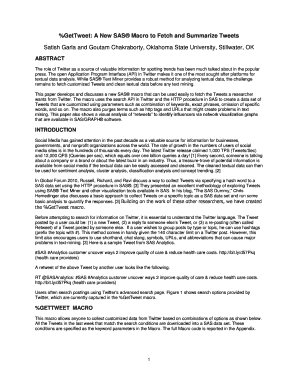Loading

Get %gettweet A New Sas Macro To Fetch Form
How it works
-
Open form follow the instructions
-
Easily sign the form with your finger
-
Send filled & signed form or save
How to use or fill out the %gettweet A New Sas Macro To Fetch Form online
The %gettweet A New Sas Macro To Fetch Form allows users to customize and fetch Tweets from Twitter based on specific parameters. This guide provides step-by-step instructions for completing the form effectively.
Follow the steps to fill out the form online.
- Click ‘Get Form’ button to obtain the form and open it in the editor.
- In the 'WORDS' field, enter all the words you want to search for. This will filter Tweets to only those containing these words.
- If you have an exact phrase to search, enter it in the 'PHRASE' field. Tweets containing this phrase will be returned.
- Specify any individual words to include in your results using the 'ANY' field. This serves as an 'OR' condition.
- To exclude specific words from your search results, utilize the 'NONE' field by entering those words.
- If you wish to target specific hashtags, fill out the 'HASH' field with the desired hashtag.
- Use the 'FROM' field to enter the username of the Tweeter from whom you want to collect Tweets. Note that only one username can be entered at a time.
- In the 'SINCE' and 'UNTIL' fields, provide a date range for your search in the format YYYY-MM-DD to filter Tweets by the specified time period.
- For only those Tweets that have a question mark, enter '1' in the 'QUESTION' field.
- Generate the base64 encoded string of your Twitter username and password as required in the 'CODE' field.
- Specify the 'PATH' field to indicate where the fetched data sets will be saved.
- Once all fields are filled out, review your entries and make any necessary adjustments before submitting the form.
- After submitting, you can save changes, download, print, or share the form as needed.
Complete the %gettweet A New Sas Macro To Fetch Form online to start utilizing Twitter data for your research.
The SCAN function is focused on retrieving words based on position, while the FIND function searches for a specific substring within a string. FIND returns the starting position of the substring, providing a different perspective on string manipulation. Understanding these distinctions enhances your coding toolkit, especially when working with tools like %gettweet A New Sas Macro To Fetch Form.
Industry-leading security and compliance
US Legal Forms protects your data by complying with industry-specific security standards.
-
In businnes since 199725+ years providing professional legal documents.
-
Accredited businessGuarantees that a business meets BBB accreditation standards in the US and Canada.
-
Secured by BraintreeValidated Level 1 PCI DSS compliant payment gateway that accepts most major credit and debit card brands from across the globe.


